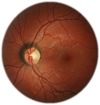Lecture 4 Flashcards
what is the magnification of the direct ophthalmoscope?
15x - magnification is dependent on patient and examiners refractive error
when is the cobalt blue filter used?
with the 20D lens and fluorescein to evaluate the cornea
what does the red-free filter help to identify?
hemorrhages, choroidal nevus vs. retinal pigmentation, NFL loss and ON rim tissue
where should your ending point be for direct ophthalmoscopy?
about 1.5 to 3mm from eye (middle finger touching cheek) and 15-20 degrees off visual axis
why should you try and keep both eyes open during direct ophthalmoscopy?
to reduce the amount of accommodation
what are some limitations of direct ophthalmoscopy?
lack of stereopsis, close working distance, refractive error dependent, and dependent on pupil size and lens
what is the diagnostic code for an extended ophthalmoscopy?
CPT 92225 (first visit) and 92226 (subsequent visits)
why is extended ophthalmoscopy one of the most audited codes by Medicare?
you cannot perform extended ophthalmoscopy and fundus photos in the same visit
how many colors are preferred in extended ophthalmoscopy?
4-6 colors and all items must be identified
what are the red colors used for in retinal mapping?
light red = attached retina
dark red = retinal arteries, pre-retinal or intraretinal hemorrhages
what is light blue used for in retinal mapping?
retinal detachment
what is dark blue used for in retinal mapping?
retinal veins, margins of retinal break and lattice is outlined in blue with inside crosslines
what is black used for in retinal mapping?
chorioretinal pigmentation
what is yellow used for in retinal mapping?
intraretinal or subretinal exudates, CWS
what is brown used for in retinal mapping?
nevi, melanomas, choroidal detachments
what is green used for in retinal mapping?
vitreous opacities
what is the Gulstrand principle?
BIO narrows the users PD - need to place the illuminating/viewing beams within the patients pupillary aperture
if your lens has a full view while looking at the patients superior temporal retina, what area are you actually viewing?
mid-periphery the periphery should be an elliptical/oval shape (not filling whole lens)
how do you compensate for elliptical pupils in extreme gazes?
slight head tilt (superior/inferior views may require a chin tuck or lift)
if you see something at the edge (not center) of your FOV in the lens, how do you bring it in the center?
scan towards it
if the patient is looking up and nasal (OD) - you see the vortex veins in the center of your lens, how do you bring the ora into view?
scan/sweep the lens more to the far periphery = ora will be near your thumb
what are “dark” retinal color changes?
Nevus, CHRPE, optic nerve choroidal ring, peripapillary atrophy, choroidal pigment changes near ampullae in tigroid and brunette fundi
what are “white” retinal color changes?
CWS, infarction/retinal edema, myelination
what are yellow-white retinal color changes?
drusen, exudates, emboli































